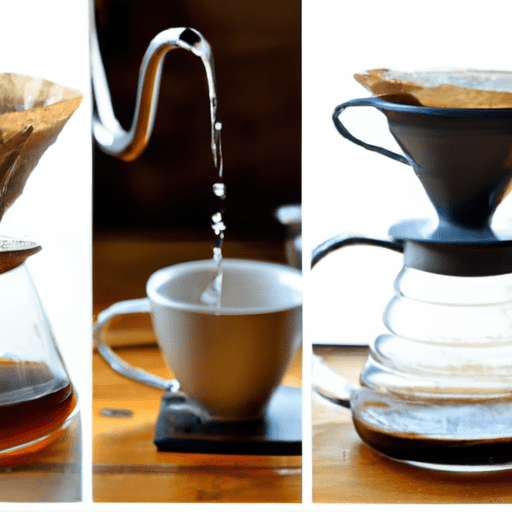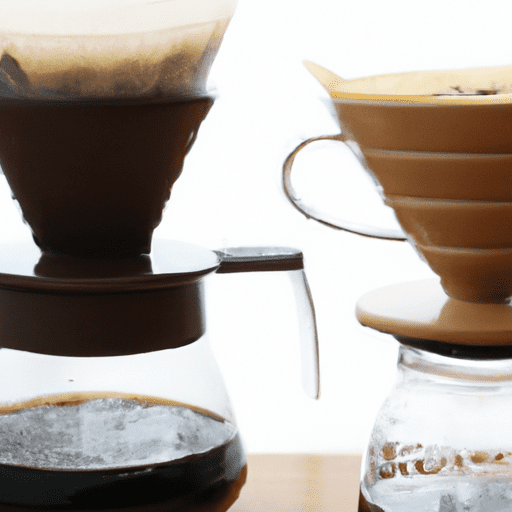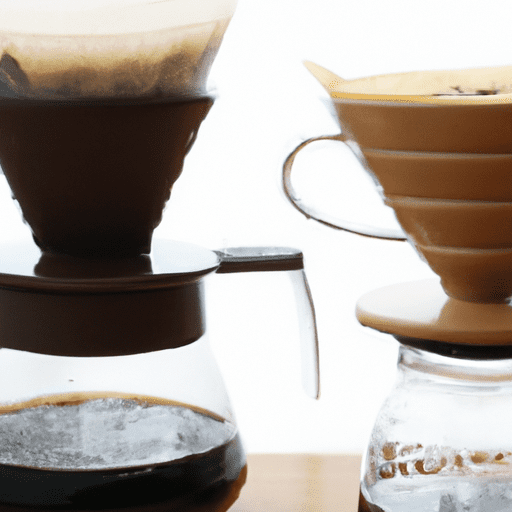Your morning cup of Joe plays a pivotal role in kick-starting your day. Nestled in the comfort of your kitchen, you might have often found yourself pondering the nuances between Pour Over and Filter Coffee. Let us embark on this enlightening journey where we will dispel the fog surrounding these two coffee brewing methods and unlock a newfound appreciation for your beloved beverage. This expedition into the heart of these brewing styles is sure to tantalize your taste buds and elevate your coffee experience to new heights. So, brace yourself, it’s time to illuminate the difference and similarities between the delightful world of Pour Over and Filter Coffee.

What is Pour Over Coffee?
Definition of pour over coffee
Pour over coffee, as the name implies, is a brewing method where hot water is poured over coffee grounds, that are held in a filter, allowing the brewed coffee to drip down into a carafe or cup below. The pouring is done manually, making the process slow and methodical, lending to an overall richer, clearer cup of coffee.
History of pour over coffee
The history of pour over coffee dates back to the early 20th century. The technique was first introduced in Germany by a housewife named Melitta Bentz, who was dissatisfied with the coffee grounds in her brew. She invented the method by using blotting paper from her son’s school notebook as a filter. This method has gained popularity in recent years amongst coffee enthusiasts and experts, who appreciate the control and precision pour over brewing allows.
Benefits of pour over coffee
There are a few key benefits of pour over coffee. First and foremost, it allows you total control over the brewing process. You can adjust the speed, volume, and temperature of the water poured over the grounds. This allows you to manipulate the final flavor of your brew, making it possible to bring out subtle notes and flavors in different types of coffee beans. Not only that, but the method also leads to a clean, robust cup of coffee.
What is Filter Coffee?
Definition of filter coffee
Filter coffee, also known as drip coffee, is made using a brewing device that often consists of a carafe on the bottom and a compartment on top where a paper or metal filter holds the coffee grounds. Hot water drips onto the coffee grounds and then gradually filters through, dropping into the carafe below. This method can be done manually or automatically with the aid of a machine.
History of filter coffee
The history of filter coffee can also be traced back to Melitta Bentz as she revolutionized the brewing process with her coffee filter innovation. However, the automatic drip coffee maker that is common today was not popularized until the mid-20th century. It was introduced by the Bunn-O-Matic Corporation and has become a staple in many households due to its convenience.
Benefits of filter coffee
One of the main benefits of filter coffee is convenience. Most filter coffee machines do all of the work for you and can even be programmed to start brewing at a specific time. This makes filter coffee a very popular choice for busy mornings. Additionally, the filter captures any coffee grounds or sediment, leading to a clear cup of coffee without any grit or sludge.
Brewing Process
Pour over brewing process
Make pour over coffee starts by placing a filter in a brewer and then adding coffee. The amount of coffee used varies based on personal taste, but a general rule of thumb is to use two tablespoons of coffee for every 170 grams of water. Boil your water and then allow it to cool slightly before pouring it over the coffee grounds. pour the water steadily and slowly, starting in the middle and working your way to the edges. This whole brewing process usually takes about three to four minutes.
Filter brewing process
Filter brewing, on the other hand, begins by placing a filter in the coffee machine and then adding your coffee grounds. After that, you simply fill the machine’s water tank with the necessary amount of water, press a button, and wait. The machine does all the pouring and brewing for you. The time it takes will vary by machine, but generally, it takes about five to ten minutes.
Comparison of brewing methods
In comparing the two methods, pour over brewing gives you more control over the brewing variables and often results in a more flavorful cup of coffee. On the flip side, filter brewing is convenient, more straightforward, and more consistent because the machine controls all the variables.

Brewing Equipment
Pour over equipment
Pour over coffee requires a few pieces of specific equipment. This includes a pour over brewer, which can be anything from a simple ceramic cone to an elaborate glass carafe, a filter, and a pouring kettle. The pouring kettle is essential because it allows you to control the speed at which you pour the water onto the coffee grounds.
Filter equipment
Filter coffee, meanwhile, requires a brewing device, which is typically an automatic drip coffee machine. This kind of machine will take care of all the brewing for you. Some models have additional features like programmable start times, built-in grinders, and thermal carafe to keep the coffee warm.
Pros and cons of each equipment
Pour over brewing requires more time, attention, and skill, but it also results in a high-quality brew. The equipment is also generally less expensive and easier to clean. Filter coffee machines, however, are more convenient and can be left unattended to finish brewing. They can also make coffee for multiple people at once. The downside is that they can be more expensive and are harder to clean.
Flavor Profile
Pour over flavor profile
A correctly made pour over coffee can highlight the unique flavors and characteristics of different kinds of coffee beans. The result is usually a clean, robust cup of coffee with high clarity of flavors. Bright, fruity, and floral notes are often more noticeable in pour over coffee than other brewing methods.
Filter flavor profile
Filter coffee, on the other hand, often produces a balanced and consistent flavor profile. The taste can vary depending on the kind of coffee used and the specific machine, but in general, filter coffee has a richer and bolder flavor compared to pour over coffee.
Differences in taste and aroma
The biggest difference in taste between the two methods comes down to the clarity of flavor. Pour over tends to allow you to taste individual flavor notes more clearly, while filter coffee blends these different flavors together, producing a well-rounded brew.
Brewing Control
Pour over control
Pour over brewing is all about control. You have complete control over every variable in the brewing process, from the water temperature to the pouring speed, which allows you to perfectly tune your brew to your preference. This aspect can also make the process more complicated, however, as it requires a certain skill level to make a well-balanced cup of coffee.
Filter control
With filter coffee, the level of control is significantly lessened. The coffee machine decides the water temperature and brewing time. However, some higher-end machines allow you to control the brew strength and also schedule brewing times.
Impact on brewing outcomes
The level of control you have in each brewing method has a significant impact on the brewing outcomes. The more control you have, as with the pour over method, the more potential there is for a better brew. However, more control also means there is more chance for error if you don’t know what you’re doing. Filter coffee machines offer less control but with more consistency and accessibility.
Brewing Time
Pour over brewing time
Pour over brewing is a slower method, taking about three to four minutes. This doesn’t include the time it takes to boil the water and prepare the coffee grounds, though. Despite being time-consuming, many coffee lovers find this brewing process therapeutic and worth the time and effort for a superior cup of coffee.
Filter brewing time
Filter coffee brewing, especially when done with a machine, is much faster. It can usually brew an entire pot of coffee in about five to ten minutes. This convenience and speed make filter coffee a more suitable method for those in a hurry or prefer the ease of an automatic brew.
Efficiency and convenience
While pour over brewing might be more labor-intensive and time-consuming, this method is often credited with producing a more fabulous cup of coffee. However, filter coffee certainly wins when it comes to efficiency and convenience, particularly for those who need to brew large amounts of coffee at a time or simply prefer simplicity.
Brewing Skill
Pour over brewing skill
Making pour over coffee is a skill that takes time to perfect. It requires patient learning and practice as you experiment with different pouring techniques, grind sizes, and coffee-to-water ratios. However, learning this skill can be very rewarding, as you gradually start to understand coffee’s subtle nuances and how to extract flavor more efficiently.
Filter brewing skill
In comparison, making filter coffee, especially with a machine, requires minimum skill. It’s a matter of adding coffee grounds and water and pushing some buttons. That said, there is still some skill involved in measuring the right amount of coffee and water to get your desired strength and flavor.
Complexity and learning curve
While pour over brewing is undoubtedly more complex and has a steeper learning curve, it gives you a greater appreciation for the art of making coffee. On the other hand, filter coffee brewing allows just about anyone to make a decent cup of coffee with little effort or training.
Popular Pour Over Methods
Chemex
The Chemex is a popular pour-over brewer known for its elegant design. The Chemex uses thicker filters, which remove more oils and fine particles from the brew, resulting in a clean and bright tasting cup of coffee.
Hario V60
The Hario V60 is another popular pour over method, favored for its simplicity and dependability. The distinctive V-shaped cone with a single large hole allows for a uniform brew and offers versatility in flavor profile based on the pouring techniques used.
Kalita Wave
The Kalita Wave, named for its wave-shaped filters, uses a flat-bottom design, which results in a more even extraction and a balanced flavor. It might be less known compared to a Chemex or Hario V60, but it enjoys a loyal following among coffee connoisseurs.
AeroPress
The AeroPress is a unique brewing device that combines elements of a French press and pour over brewing. It’s convenient, easy to use, and brews a rich and smooth cup of coffee quickly. This brewer is popular among travelers and outdoor enthusiasts due to its portability.
Popular Filter Coffee Methods
Automatic drip coffee maker
The automatic drip coffee maker is the most common household coffee brewer. It’s convenient, easy to use, and can brew larger quantities of coffee at a time. It’s perfect for people who drink coffee regularly and prefer a hassle-free brewing process.
French press
The French press is a manual brewing method that combines elements of immersing and filtering. It’s known for its rich, full-bodied coffee. It doesn’t require a filter, which allows more oils and fine particles into the brew, leading to a bolder flavor profile.
Siphon
The siphon, or vacuum pot, is an old-fashioned brewing method which uses a two-chambered device to create a vacuum and vapor pressure to brew coffee. It’s a more complicated method, but it’s favored by some for its theatrical brewing process and uniquely distinct flavor.
Moka pot
The Moka pot is a stovetop brewing method that uses steam pressure to push water through coffee grounds. It’s known for producing a strong, espresso-like coffee. While it requires more attention and practice than other methods, it’s popular among coffee enthusiasts who enjoy a strong dose of caffeine.
In summary, both pour over and filter coffee have their unique qualities and advantages. Depending on your lifestyle, preference, and coffee taste, you might gravitate toward one method over the other. Maybe you find the ritualistic nature of pour over brewing satisfying, or perhaps the convenience of filter coffee better suits your fast-paced lifestyle. Either way, when done correctly, both methods can brew a cup of coffee that is sure to satisfy.
